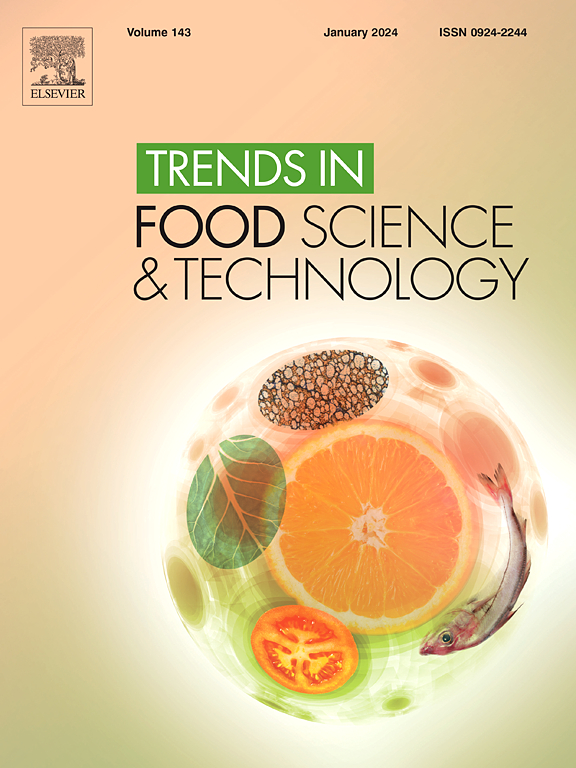Definition and strategy of intelligent foodomics for diagnosis and identification of hazards and pathogens in food-borne diseases
IF 15.1
1区 农林科学
Q1 FOOD SCIENCE & TECHNOLOGY
引用次数: 0
Abstract
Background
Foodborne diseases are defined as those caused by the ingestion of various toxins, hazardous substances and pathogens that enter the human body, usually with symptoms of infection or poisoning. Systematic screening of hazardous substances, toxins, pathogens is a prerequisite and foundation for preventing and controlling food risks and protecting consumers from foodborne illness. The introduction of Artificial Intelligence (AI) technology has facilitated the development of foodomics and provided new solutions for intelligent screening and analysis of hazards and pathogens in food and diagnosis of foodborne diseases. AI-driven foodomics is an emerging and promising strategy for food analysis that can greatly accelerate the screening of toxic and hazardous substances in food, especially the analysis and non-targeted screening of unknown or new toxicants.
Scope and methods
In this review, we have firstly defined the concept of intelligent foodomics from the perspective of artificial intelligence, proposed the feasible workflow of intelligent foodomics, and summarized the recent progress of intelligent foodomics in food hazards and pathogens screening studies (2014–2024) from different perspectives, and evaluate its advantages and disadvantages. Finally, we discussed the prospects and opportunities for the development of intelligent foodomics.
Key findings and conclusions
As a practicable paradigm, intelligent foodomics demonstrates a great application potential for screening and analysis of hazardous substances, toxins and pathogens in food, and for diagnosis of foodborne diseases. Intelligent foodomics promote to analyze toxic and hazardous substances, discover new unknown toxins, innovate high-throughput screening and risk assessment of food pathogens or hazardous substances, and diagnose and identify of foodborne diseases. In the future, the deep integration of intelligent foodomics with other methods will undoubtedly advance food safety analysis and foodborne disease diagnosis. This review provides useful reference for AI-driven foodomics strategies to further bridge the gap from laboratory-scale studies to translational food industry safety assessment and clinical diagnosis of foodborne diseases.

用于食源性疾病危害和病原体诊断和识别的智能食物组学的定义和策略
食源性疾病被定义为因摄入进入人体的各种毒素、有害物质和病原体而引起的疾病,通常伴有感染或中毒症状。对有害物质、毒素和病原体进行系统筛查是预防和控制食品风险以及保护消费者免受食源性疾病侵害的先决条件和基础。人工智能(AI)技术的引入促进了食品组学的发展,并为食品中危害和病原体的智能筛选和分析以及食源性疾病的诊断提供了新的解决方案。人工智能驱动的食品组学是一种新兴的、有前途的食品分析策略,可以大大加快对食品中有毒有害物质的筛选,特别是对未知或新毒物的分析和非靶向筛选。本文首先从人工智能的角度界定了智能食品组学的概念,提出了智能食品组学的可行工作流程,并从不同角度总结了智能食品组学在食品危害和病原体筛选研究中的最新进展(2014-2024),并对其优缺点进行了评价。最后,讨论了智能食品组学的发展前景和机遇。智能食物组学作为一种可行的模式,在食品中有害物质、毒素和病原体的筛选和分析以及食源性疾病的诊断方面显示出巨大的应用潜力。智能食品组学促进有毒有害物质的分析,发现新的未知毒素,创新食品病原体或有害物质的高通量筛选和风险评估,以及食源性疾病的诊断和识别。未来,智能食品组学与其他方法的深度融合,无疑将推动食品安全分析和食源性疾病诊断。这一综述为人工智能驱动的食品组学策略提供了有益的参考,以进一步弥合从实验室规模研究到转化食品工业安全评估和食源性疾病临床诊断的差距。
本文章由计算机程序翻译,如有差异,请以英文原文为准。
求助全文
约1分钟内获得全文
求助全文
来源期刊

Trends in Food Science & Technology
工程技术-食品科技
CiteScore
32.50
自引率
2.60%
发文量
322
审稿时长
37 days
期刊介绍:
Trends in Food Science & Technology is a prestigious international journal that specializes in peer-reviewed articles covering the latest advancements in technology, food science, and human nutrition. It serves as a bridge between specialized primary journals and general trade magazines, providing readable and scientifically rigorous reviews and commentaries on current research developments and their potential applications in the food industry.
Unlike traditional journals, Trends in Food Science & Technology does not publish original research papers. Instead, it focuses on critical and comprehensive reviews to offer valuable insights for professionals in the field. By bringing together cutting-edge research and industry applications, this journal plays a vital role in disseminating knowledge and facilitating advancements in the food science and technology sector.
 求助内容:
求助内容: 应助结果提醒方式:
应助结果提醒方式:


